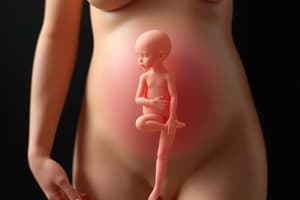Podcast
Questions and Answers
What is the main sign of puberty in girls?
What is the main sign of puberty in girls?
- Increase in hip size
- Breast development (correct)
- Pubic hair growth
- Menarche (first menstrual period)
Which hormone stimulates the growth of ovarian follicles before ovulation?
Which hormone stimulates the growth of ovarian follicles before ovulation?
- Progesterone
- Luteinizing hormone (LH)
- Follicle-stimulating hormone (FSH) (correct)
- Estrogen
What is the typical duration of a menstrual cycle?
What is the typical duration of a menstrual cycle?
- 35-40 days
- 42-46 days
- 28-32 days (correct)
- 21-25 days
Which of the following is NOT a typical sign of puberty in boys?
Which of the following is NOT a typical sign of puberty in boys?
What is the term used for the absence of menstrual periods?
What is the term used for the absence of menstrual periods?
Which hormone controls the production of estrogen in girls during puberty?
Which hormone controls the production of estrogen in girls during puberty?
What is the term used for painful menstrual periods?
What is the term used for painful menstrual periods?
Which of the following is NOT a typical sign of puberty in boys?
Which of the following is NOT a typical sign of puberty in boys?
What is the term used for the monthly release of an egg from the ovary?
What is the term used for the monthly release of an egg from the ovary?
Which hormone is primarily responsible for the changes associated with puberty in boys?
Which hormone is primarily responsible for the changes associated with puberty in boys?
Flashcards are hidden until you start studying
Study Notes
Prenatal Development
- Human development begins with the union of two sex cells or gametes, containing 23 pairs of chromosomes
- Chromosomes are composed of DNA, which contains genes, the basic unit of heredity
Genetic and Chromosomal Abnormalities
- Over 4000 human genetic disorders can occur, caused by recessive or dominant genes
- Examples include:
- Down Syndrome (trisomy 21): extra chromosome on the 21st pair, causing flattened facial features, heart defects, and intellectual disability
- Inherited diseases: genetic tests can determine if a parent is a carrier of a specific disease
- Sex-chromosomal abnormalities:
- Klinefelter's syndrome: extra X chromosome (47, XXY) in boys
- Turner syndrome: missing one X chromosome in girls
Sex Determination
- Sex chromosomes (23rd pair) determine sex
- XX for females, XY for males
Multiple Births
- Identical twins (monozygotic): formed from the same fertilized egg
- Fraternal twins (dizygotic): formed from two separate eggs, each fertilized by a different sperm
Stages of Prenatal Development
- Germinal Stage (first two weeks): cell division, morula, blastocyst, and implantation
- Embryonic Period (third to eighth week): formation of neural tube, heart, and organs
- Fetal Period (ninth week to birth): rapid growth and development of organs and body systems
Infancy and Childhood Development
- APGAR Test: assesses newborn's overall health
- Neonatal Reflexes: automatic responses in newborns, such as sucking and grasping
- Motor Development: gross motor skills (large muscle movements) and fine motor skills (small muscle movements) develop in infancy and childhood
- Body Changes: physical development during early childhood to adolescence
Adolescence
- Period of developmental transition between childhood and adulthood
- "Adolescent growth spurt": rapid increase in height and weight due to hormonal changes
- Primary Sexual Characteristics: involved in reproduction, present at birth
- Secondary Sexual Characteristics: caused by hormones, develop during puberty
- Puberty in Girls:
- Breast development, followed by menarche (first menstrual period)
- Ovarian Cycle: follicle-stimulating hormone stimulates ovarian follicles, leading to ovulation
- Puberty in Boys:
- Enlargement of testicles, followed by physical changes, including voice changes
Studying That Suits You
Use AI to generate personalized quizzes and flashcards to suit your learning preferences.




